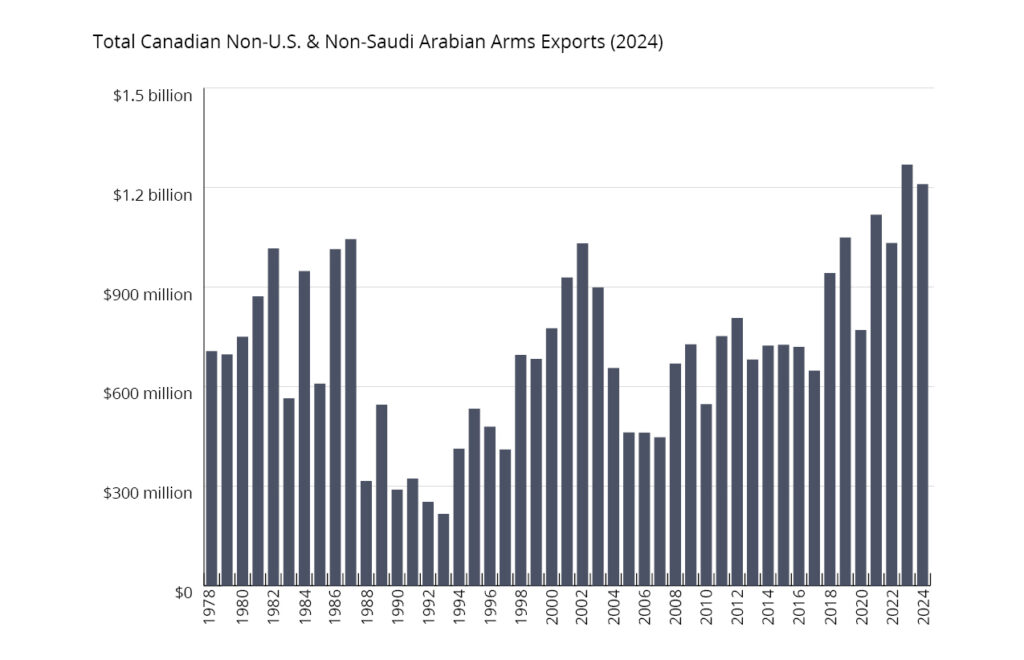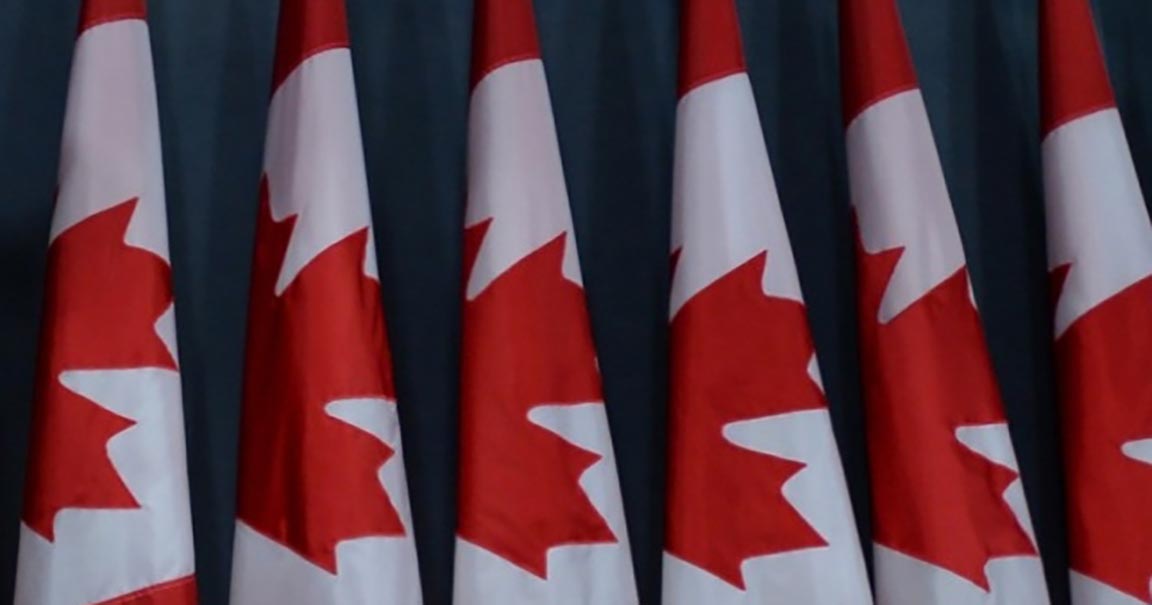Canada’s Soaring Arms Exports: What the 2024 Numbers Reveal
Canada is exporting weapons at some of the highest levels in its history. The latest government report, released in June, shows $2.5-billion in arms exports to countries outside the United States in 2024, including to states with troubling human rights records and those engaged in active conflicts.
Each year, Global Affairs Canada (GAC) publishes its annual report on military exports, detailing the weapon systems and associated components that Canada transferred to foreign countries in the previous calendar year. The 2024 report paints a stark picture: Canada’s non-U.S. arms exports were valued at $2.504 billion, the third-highest total on record, surpassed only by 2019 ($4.4 billion*) and 2021 ($3.102 billion).
And that’s only part of the story. Because weapons transfers to the U.S.—traditionally, the largest consumer of Canadian weapons—are largely exempt from Canadian export controls, they don’t appear in the official report. Yet Project Ploughshares estimates these unreported sales at more than $1 billion annually.
So where are these billions in Canadian weapons going?
Saudi Arabia: Canada’s top non-U.S. export destination
In 2024, Saudi Arabia remained the leading destination for Canadian arms exports, receiving $1.293 billion in military goods. The vast majority of this total, $1.231 billion, was for Light Armoured Vehicles (LAVs) and associated components. These LAVs are manufactured by General Dynamics Land Systems–Canada in London, Ontario.
This ongoing transfer of military hardware is part of the 2014 Canada–Saudi Arabia LAV deal, the largest arms deal in Canadian history. Canada also reports separately to the United Nations and the Arms Trade Treaty (ATT) Secretariat on the number of weapons exported. In 2024, these filings show that 63 individual LAVs were sent to Saudi Arabia.
Canada’s arms exports to Saudi Arabia, which are largely, but not exclusively, LAVs, have faced intense scrutiny by the Canadian public and civil society. This is not only due to the Saudi government’s troubling human rights record, but also because of Saudi Arabia’s deployment of Canadian LAVs in the Yemeni civil war, a conflict that resulted in the deaths of an estimated 377,000 people. Further highlighting these concerns, the UN Group of Eminent Experts on Yemen named Canada as a country that was fueling the civil war through its continued shipment of arms to combatants.
Canada’s arms transfers to Germany
Beyond Saudi Arabia, European states are also major recipients of Canadian weapons. In 2024, Germany was the second-largest non-U.S. recipient of Canadian military goods, with exports totaling $186.5 million.
The largest category of these exports, valued at $51.2 million, was “Ground vehicles and components” (Heading 2-6 of Canada’s Export Control List). It is likely that some of these armored vehicles were ultimately sent to Ukraine as military aid via Germany.
Following this, the next-largest categories were military software, valued at $45.5 million, and military aircraft and components, at $21.2 million. Canada’s annual filing to the UNROCA for the same year confirms a transfer of a single aircraft from Canada to Germany for use by German security forces, which corresponds with the latter export category.
Canadian military aid to Ukraine
The third-largest non-U.S. recipient was Ukraine, which received direct arms transfers valued at $172.6 million. The largest weapons categories outgoing to Ukraine were ground vehicles and components ($141.5 million), small arms and associated components ($23.8 million), and ammunition and associated components ($5.5 million).
Since Russia’s full-scale invasion of Ukraine in February 2022, Canada has provided billions of dollars’ worth of military goods to Kyiv, mostly in the form of military aid. Unlike traditional arms exports, military aid is managed and delivered by the Department of National Defence through a separate regulatory process that typically does not require traditional export permits. As a result, the total value of these transfers is not always included in Canada’s annual report on military exports, which means the country’s true export volume is understated.
In 2024, Canadian military aid to Ukraine that was not captured in the reported $172.1 million included 277 units of Mk-83 bombs, chassis for both Coyote LAVs and M113 armoured personnel carriers, and 184 units of LAU-7 guided missile launchers.
Türkiye: a renewed arms trade relationship
Another major development in 2024 was the renewal of Canadian arms exports to Türkiye.
In 2020, Canada suspended the transfer of weapon systems to Türkiye after it was revealed that the Turkish government had diverted Canadian technology to its ally Azerbaijan for use in the invasion of Nagorno-Karabakh. The equipment in question—L3Harris Wescam CMX-15D targeting sensors, mounted on Turkish-made Bayraktar TB2 drones—was used to guide airstrikes during the conflict. In the years before the 2020 export freeze, Türkiye had procured hundreds of millions of dollars’ worth of these systems, which were also diverted to other conflict zones, including Libya, in violation of a standing UN arms embargo.
Yet, following pressure from the Turkish government, in 2024, Türkiye was the next-largest non-U.S. recipient of Canadian military goods, receiving $107.8 million. Since 2024, Canada has transferred more than $100 million worth of targeting systems alone to the country. While GAC has stated that these renewed exports are supported by end-use assurances, Türkiye’s past disregard for end-use controls raises questions about the reliability of new promises.
Canada’s partial pause on arms to Israel
In January 2024, GAC paused the issuance of new arms export permits to Israel. This decision followed a record year for Canadian military exports to Israel in 2023, valued at over $30 million. The pause was prompted by Israel’s conduct throughout the war in Gaza, which, at the time of publication, has killed more than 60,000 Palestinians. Due to Israel’s flagrant violation of international humanitarian law throughout the conflict, it is widely understood that transferring arms to Israel that could be used in Gaza constitutes a violation of Article 7 of the ATT.
Despite the suspension of new export permits at the beginning of the year, arms transfers to Israel in 2024 still totaled $18.9 million. This significant amount was possible because the January 2024 decision only stemmed the authorization of new permits, and had no effect on transfers that had been authorized prior to the pause. Although this represents a reduction of more than one-third compared to 2023, the value of exports in 2024 still exceeded almost all previous years on record.
Canada’s suspension on new export authorizations to Israel has several limitations. It does not affect previously authorized transfers, allowing shipments to continue throughout 2024. Additionally, it does not cover indirect arms transfers to Israel through the United States. A key example of this is Canadian-made components integrated into American-made F-35 combat aircraft, which Israel is an eventual recipient of
Canada’s growing arms industry and beyond
While the Annual Report often highlights significant arms transfers to individual countries with problematic human rights records, a broader trend is also apparent: Canada’s total arms exports to the rest of the world are growing.

This trend is exemplified by isolating the arms export data for Saudi Arabia, the largest non-U.S. recipient of Canadian weapons, due to its outsized value. After 2023 ($1.268 billion), the value of Canada’s military exports to all other international customers in 2024 was the highest on record, with total transfers exceeding $1.21 billion.
This trend illustrates Canada’s growing role in global defense procurement, particularly with its European allies and within the context of the war in Ukraine. And as the target for NATO military expenditures has recently risen to a massive 5% of GDP, it is only likely that Canada’s arms exports will continue to grow in markets other than Saudi Arabia.
Scale, Scrutiny, and Consequences
Canada’s arms exports are expanding faster than ever, with record exports even beyond Saudi Arabia. This growth ties Canada more closely to conflicts abroad and forces a reckoning with how its weapons trade aligns with its values and global reputation.
*All values are in Canadian dollars (CAD). Values originally reported in years prior to 2025 are represented in constant CAD (2024) and therefore may appear larger than when initially reported.
Published in The Ploughshares Monitor Autumn 2025

